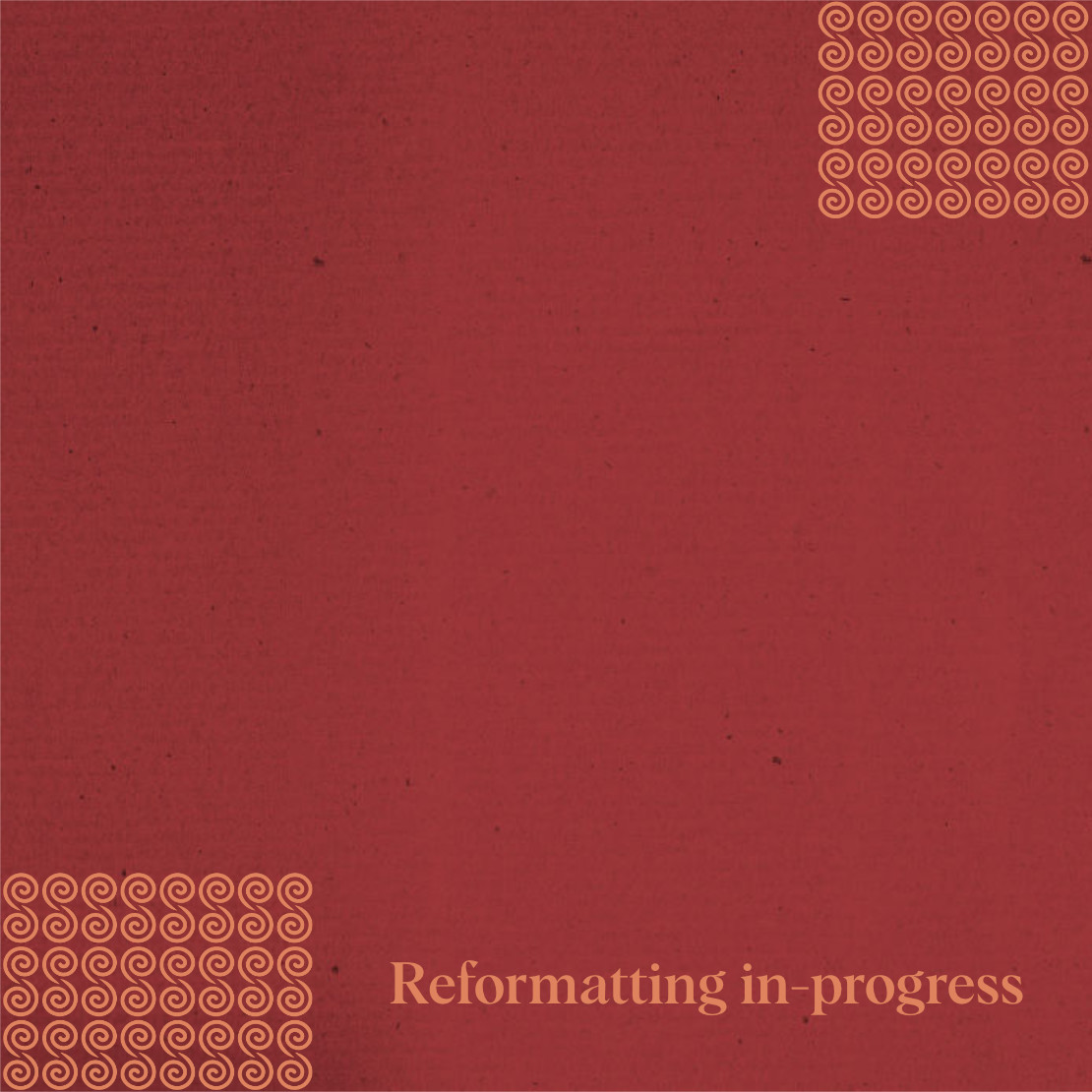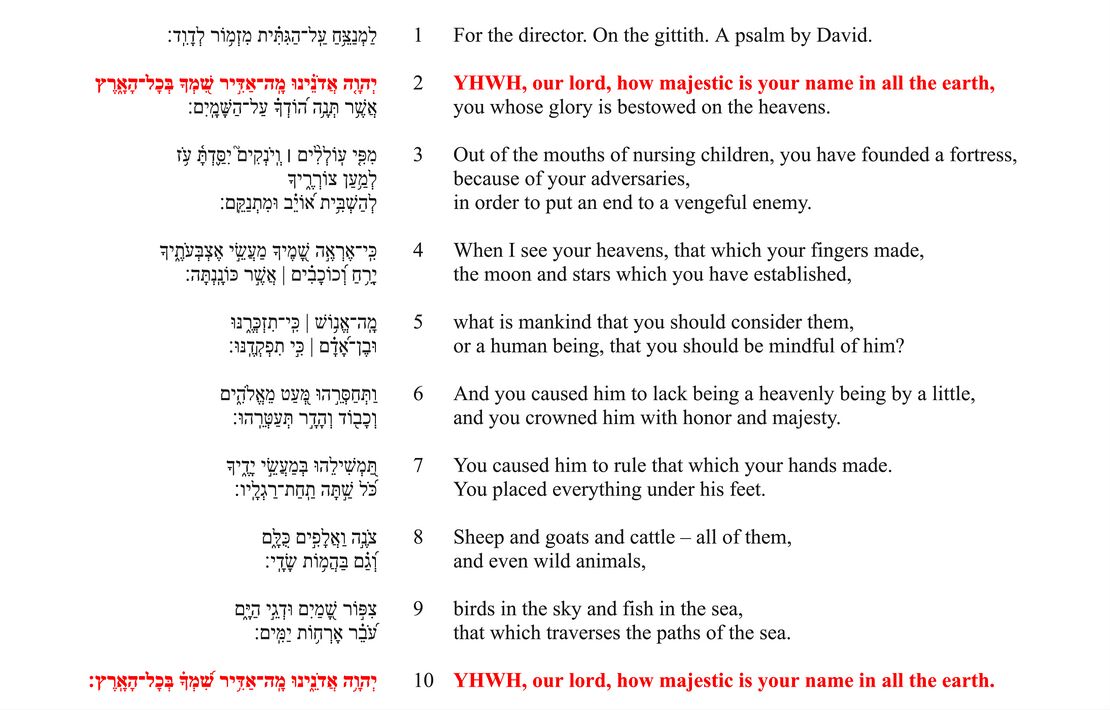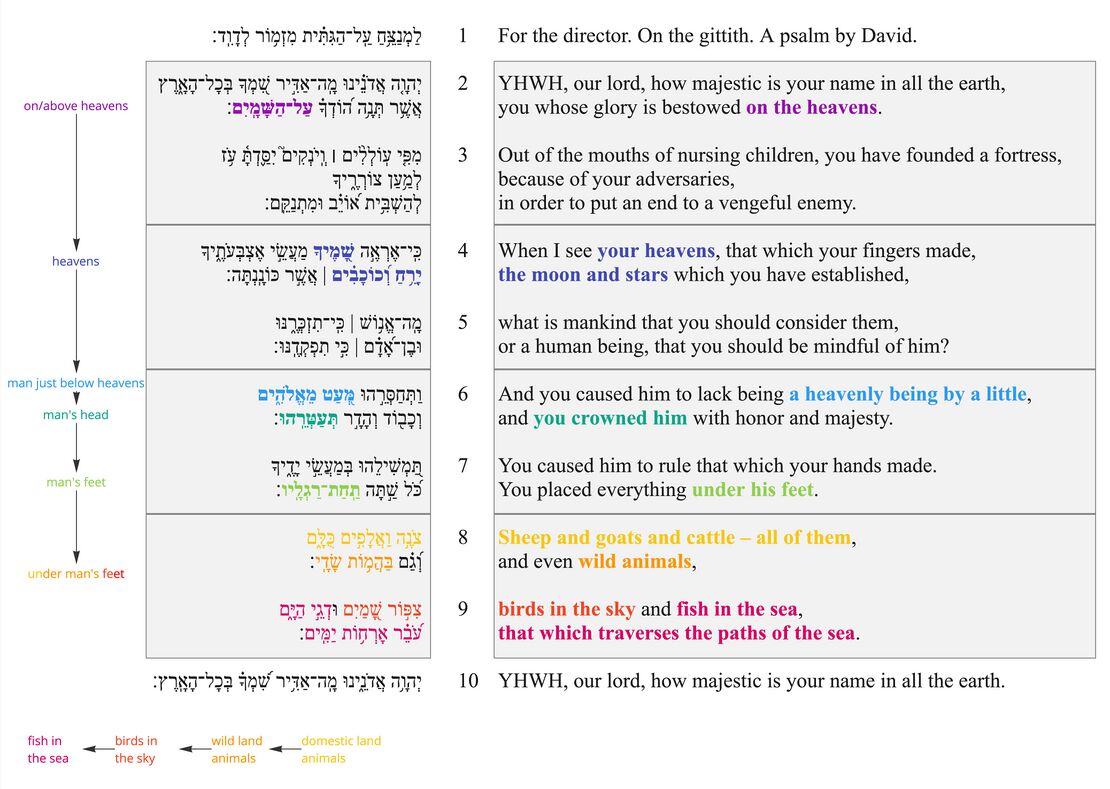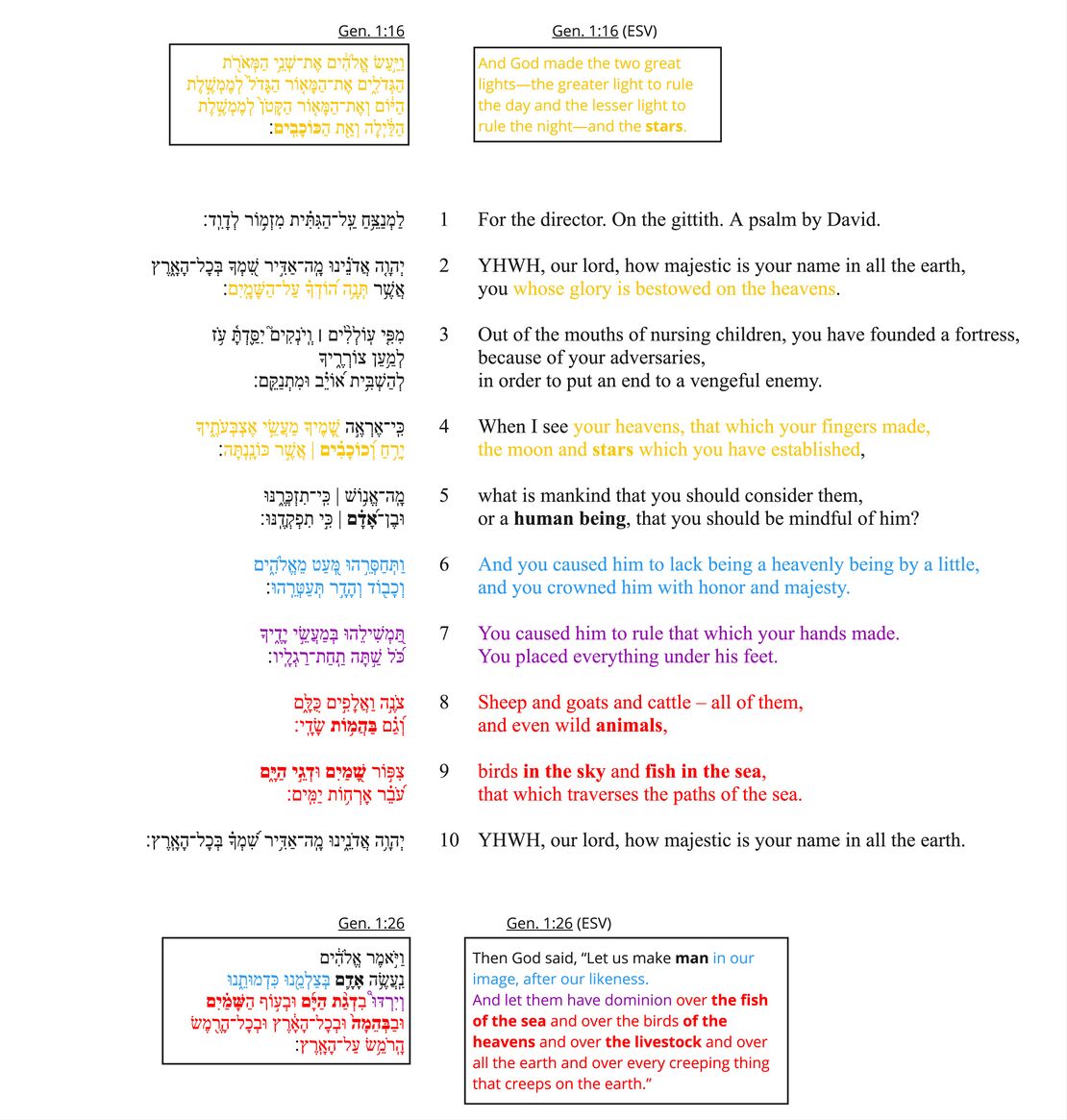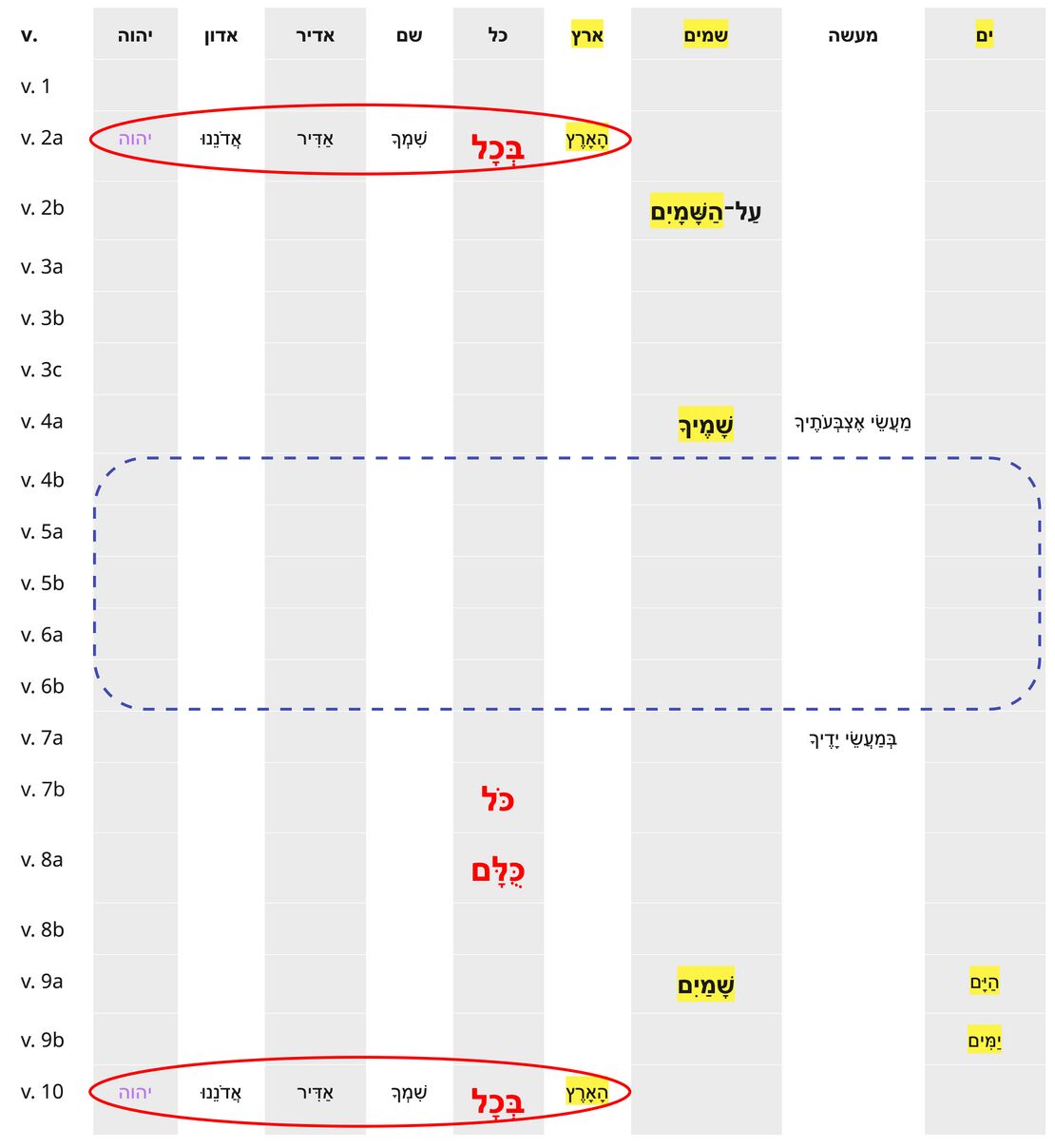Psalm 8 Poetic Features
Poetic Features
In poetic features, we identify and describe the “Top 3 Poetic Features” for each Psalm. Poetic features might include intricate patterns (e.g., chiasms), long range correspondences across the psalm, evocative uses of imagery, sound-plays, allusions to other parts of the Bible, and various other features or combinations of features. For each poetic feature, we describe both the formal aspects of the feature and the poetic effect of the feature. We assume that there is no one-to-one correspondence between a feature’s formal aspects and its effect, and that similar forms might have very different effects depending on their contexts. The effect of a poetic feature is best determined (subjectively) by a thoughtful examination of the feature against the background of the psalm’s overall message and purpose.
How Majestic
If an emendation or revocalization is preferred, that emendation or revocalization will be marked in the Hebrew text of all the visuals.
| Emendations/Revocalizations legend | |
|---|---|
| *Emended text* | Emended text, text in which the consonants differ from the consonants of the Masoretic text, is indicated by blue asterisks on either side of the emendation. |
| *Revocalized text* | Revocalized text, text in which only the vowels differ from the vowels of the Masoretic text, is indicated by purple asterisks on either side of the revocalization. |
Feature
The last line of the psalm (v. 10) repeats the first line (v. 2a) verbatim: יְהוָה אֲדֹנֵינוּ מָה־אַדִּיר שִׁמְךָ בְּכָל־הָאָרֶץ
Effect
"A perfect circle is closed: the majesty of God, affirmed at the beginning, restated verbatim at the end, but with the sense accrued through the intervening eight lines of what concretely it means for His name to be majestic throughout the earth."[1] The "sense accrued" throughout the psalm is surprising. The opening declaration of Yahweh's majesty (v.2ab) is expounded, perhaps unexpectedly, with images of helpless children (v.3) and frail humans (v.5). When the same words are repeated in v.10, the meaning has developed in a surprising way: Yahweh's royal majesty is manifested in weakness.
From Top to Bottom
If an emendation or revocalization is preferred, that emendation or revocalization will be marked in the Hebrew text of all the visuals.
| Emendations/Revocalizations legend | |
|---|---|
| *Emended text* | Emended text, text in which the consonants differ from the consonants of the Masoretic text, is indicated by blue asterisks on either side of the emendation. |
| *Revocalized text* | Revocalized text, text in which only the vowels differ from the vowels of the Masoretic text, is indicated by purple asterisks on either side of the revocalization. |
Feature
"Throughout the first six verses of the poem, the poet has subtly woven in a motif of vertical descent: v.2c above heavens → v.4a heavens... moon and stars → v.6a but a little lower than heavenly beings → v.6b crowned them (a reference to the head) → v.7a hands → v.7b feet. Having descended to earth, the psalmist now changes directions and describes a horizontal vector that moves outward from human society: sheep and oxen → beasts of the field → birds → fish → whatever passes the paths of the seas."[2]
Effect
YHWH's majesty is evident in the greatest heights of the heavens (v. 2b) as well as in the lowest depths of the ocean (v. 9b). The whole world displays the majesty of its creator and king (vv. 2a, 10).
At the center of creation (and the center of the psalm) are humans who stand between heaven and earth as the "image of God" (Gen 1:26f) and the mediators of God's rule.
In the Beginning
If an emendation or revocalization is preferred, that emendation or revocalization will be marked in the Hebrew text of all the visuals.
| Emendations/Revocalizations legend | |
|---|---|
| *Emended text* | Emended text, text in which the consonants differ from the consonants of the Masoretic text, is indicated by blue asterisks on either side of the emendation. |
| *Revocalized text* | Revocalized text, text in which only the vowels differ from the vowels of the Masoretic text, is indicated by purple asterisks on either side of the revocalization. |
Feature
Ps 8:8-9 lists three basic categories of animals: (1) land animals, domestic and wild (v. 8), (2) birds (v. 9aα), (3) fish (v. 9aβb). This taxonomy closely resembles the list of animals in Gen 1:26-28, though the two passages use slightly different terminology (עוף vs צפור for "birds" and בהמות שדי vs חיה for "wild animals"): (1) land animals, domestic and wild (2) birds, (3) fish.
In addition to the listing of animals, the description of man's dominion in Ps 8:6-7 also recalls Genesis 1:26-28 and the creation of man as God's image "to rule" the animals. Likewise, the description of "glory on the heavens" (v. 2b) may recall the dominion which YHWH gave to the heavenly bodies (Gen 1:16-18).
Effect
The parallels between Gen 1:26-28 and Ps 8 lead Waltke to conclude that "Psalm 8 is Genesis 1:26-28 set to music."[3] Similarly, Gentry says that Ps 8:6-9 is "a word-by-word commentary and meditation on Genesis 1:26-28."[4] The different terms used for wild animals and birds in Ps 8 – words which are normally used for domestic creatures – may have been chosen in order to affirm the fact that these creatures are subject to humans.[5]
Repeated Roots
The repeated roots table is intended to identify the roots which are repeated in the psalm.
| Repeated Roots legend | |
|---|---|
| Divine name | The divine name is indicated by bold purple text. |
| Roots bounding a section | Roots bounding a section, appearing in the first and last verse of a section, are indicated by bold red text. |
| Roots occurring primarily in the first section are indicated in a yellow box. | |
| Roots occurring primarily in the third section are indicated in a blue box. | |
| Roots connected across sections are indicated by a vertical gray line connecting the roots. | |
| Section boundaries are indicated by a horizontal black line across the chart. | |
